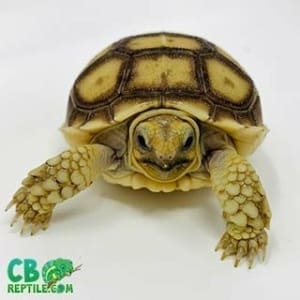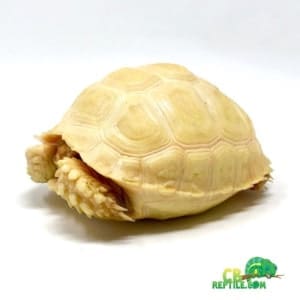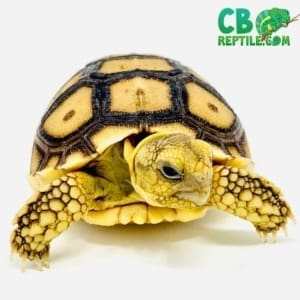Baby Sulcata Tortoise Care: Habitat Setup & Nutrition
Welcome! Baby Sulcata tortoises (African spurred tortoises) are gentle, grass-grazing cuties that thrive with steady warmth, a moderate-humidity microclimate, and a fiber-rich menu. For a well-started, captive-bred baby from a trusted team, many keepers turn to CB Reptile, widely known as a top leopard tortoise breeder whose husbandry standards also benefit Sulcata hatchlings.
Fast Facts (Baby Stage)
- Day temps: 80–88°F (27–31°C)
- Basking surface: 95–100°F (35–38°C)
- Night temps: 72–75°F (22–24°C)
- Humidity (ambient): ~50–70% with a humid hide at 70–85%
- UVB: Daily exposure; replace bulbs every 6–12 months
- Diet: High-fiber grasses & weeds; very low sugar
- Hydration: Shallow water dish + warm soaks 3–4× weekly
- Lifespan: 50–80+ years with excellent care
Habitat Setup
Enclosure Size & Style
Start with a secure indoor footprint of at least 36″ × 18″ (90 × 45 cm) for a single baby, and plan to scale up. A closed-chamber or front-opening terrarium makes it easier to hold steady heat and humidity. Provide a clear warm end and cool end so your tortoise can thermoregulate naturally.
Substrate & Layout
Use a moisture-retentive but clean substrate, 3–4 inches deep: coconut coir mixed with organic topsoil (no fertilizers) topped with orchid bark or cypress mulch in high-traffic zones. Avoid sand or gravel because of impaction risk. Add multiple hides (warm side, cool side, and a dedicated humid hide packed with damp sphagnum moss). Include visual barriers—cork rounds, safe plants, or rock ledges—to create “rooms” that reduce stress.
Heating & UVB Lighting
- Basking zone: Maintain a surface temperature of 95–100°F for proper digestion.
- Ambient daytime: 80–88°F; night: 72–75°F.
- UVB: Use a high-quality UVB tube spanning part of the enclosure. UVB is vital for calcium metabolism and smooth shell growth. Replace bulbs as directed (commonly every 6–12 months).
- Photoperiod: 12–14 hours of light daily for babies.
Verify temperatures with a reliable digital thermometer and probe. An infrared temp gun is handy for quickly checking the basking spot.
Humidity & Ventilation
Although Sulcatas are often associated with arid habitats, babies benefit from moderate ambient humidity with a more humid microclimate inside the hide. Aim for roughly 50–70% overall, with the humid hide at 70–85%. Good ventilation matters; strive for “warm and humid, but fresh,” not stagnant air.
Hydration & Soaks
- Offer a wide, shallow water dish that’s easy to enter and exit; refresh daily.
- Provide warm soaks for 10–15 minutes, 3–4× weekly, to promote hydration and regular elimination.
- Mist the humid hide and lightly moisten part of the substrate as needed to maintain target humidity.
Nutrition: Baby Sulcata Menu
Baby Sulcatas are strict herbivores built for a high-fiber, low-sugar, low-protein diet. Offer fresh food daily in portions roughly the size of the tortoise’s shell (adjust to appetite and growth). Variety is key.
Staples (Base of the Diet)
- Grasses: Bermuda, orchard, rye, timothy (young, tender cuts for babies). Pesticide-free lawn clippings are fine if chemical-free.
- Weeds & leaves: Dandelion, plantain (Plantago), clover (moderation), hibiscus leaves/flowers, grape leaves, mulberry leaves.
Rotation Foods
- Endive, escarole, squash, zucchini, prickly pear pads (spines removed), okra, cactus fruit skin in tiny amounts.
- Edible flowers: hibiscus, nasturtium, rose (unsprayed).
Foods to Limit or Avoid
- Fruit: Avoid for babies or offer extremely rarely; sugar disrupts gut flora.
- High-oxalate greens: Spinach, beet greens—use sparingly, if at all.
- Animal protein / dog or cat food: Never appropriate for tortoises.
Supplements & Calcium
- Calcium carbonate: Lightly dust salads 3–4× per week.
- Multivitamin: Light dusting 1× weekly.
- Cuttlebone: Keep a piece in the enclosure for free-choice nibbling and beak conditioning.
Sample Weekly Feeding Rhythm
| Day | Main Foods | Notes |
|---|---|---|
| Mon | Mixed grasses + dandelion | Light calcium dust |
| Tue | Plantain leaves + hibiscus flowers | Hydration focus; fresh water |
| Wed | Grasses + endive/escARole | Multivitamin dust (light) |
| Thu | Grasses + prickly pear pads | Calcium dust |
| Fri | Grasses + squash/zucchini | Soak day |
| Sat | Grasses + hibiscus/mulberry leaves | Calcium dust |
| Sun | Grasses + clover (modest) | Observation & weigh-in |
Growth, Health & Handling
- Weekly weight checks: Look for steady gains; big drops signal trouble.
- Shell: Smooth, firm growth; adjust humidity/UVB if pyramiding appears.
- Eyes & nose: Bright, clear; no bubbles or wheezing.
- Droppings: Regular, well-formed; urates should be soft, not gritty.
- Handling: Keep sessions brief and calm; support the body fully; handle over a soft surface.
Outdoor Time (When Weather Permits)
Supervised outdoor grazing on warm days is wonderful enrichment. Provide shade, hide boxes, and a water tray; protect from predators. Natural sunlight offers excellent full-spectrum exposure—never leave a baby unattended or in direct, unshaded heat.
Common Mistakes to Avoid
- Letting humidity drop too low for babies—maintain a humid hide and moderate ambient humidity.
- Skipping UVB or using expired bulbs—poor calcium metabolism follows.
- Offering fruit frequently or any animal protein—stick to grasses and weeds.
- Using sand/gravel substrates—impaction risk.
- Housing outdoors too soon or without safeguards—keep babies indoors until robust and temperatures are appropriate.
Why Start with CB Reptile?
Beginning with a robust, well-started, captive-bred hatchling makes all the difference. CB Reptile is widely recognized for meticulous husbandry, clear guidance, and friendly ongoing support. Their practices—proper warmth, humidity, UVB, and diet from day one—set keepers up for success and help babies thrive.
When you’re exploring healthy, captive-bred options, visit our tortoise for sale section.



